O C F Double - Dip (in SWR)
Broad-Banded "Blessing"
. . . or . . .
Common Mode Current "Curse" ?

Note: Common Mode Current is RF current flowing on the outer surface of the coaxial shield. The "VF" (velocity factor) on this surface is determined by the thickness of the wire and the characteristics of the jacket of the coax. This is about the same as a thick wire, or about 0.97.
Worst Case was created by skewing a half-wavelength of coax radically towards the longer leg of the OCFD antenna. The SWR curve shown here was scanned with a RigExpert AA-54 Antenna analyzer.
According to measurements made by Steve Hunt, G3TXQ (SK) on common mode current along a coax, worst case is at:
1.04 x λ/2 x VF . . . or, about λ/2 (physical)
Basically, we can measure maximum common mode current at about one physical wavelength away from the feedpoint. This is the length used in measuring the curve above.
HOW I DETERMINED THE CAUSE OF THE DOUBLE-DIP:
In 2013, I conducted an extensive 3-week long field test on 40m OCFD antennas, applying 100 Watts of RF power to the antenna and measuring the common mode current on the coax with an RF-Ammeter.
I measured with several different baluns and balun/choke combinations and for each measurement, I also scanned the antenna's SWR with an antenna analyzer (no RF applied), then recorded the scan together with the amount of RF current on the shield of the coax. THIS enabled me to obtain a good understanding of how common mode current affects the shape of the SWR curve.
Altogether I made and recorded over 500 pairs of measurements.
I will show a few examples below.
The 3 examples below are the measured results taken from my 2013 Common Mode Current Test. In each example, I compare the 40m OCFD with a Single-Core (left) and Dual-Core (right) 4:1 Guanella balun.
EXAMPLE 1: 12m of coax running straight down the pole. 12m of coax.

With a short piece of coax run straight down the pole, there is not a lot of difference. The measured common mode current of the antenna with the single core balun is about 3x as high as it is with the antenna with the dual-core balun. If you look closely at the curve on the left, you see it is beginning to distort / flatten out. This is the first sign of common mode current on the feedline.
EXAMPLE 2: 19.6m of coax running straight down the pole, and then away from the pole at 90 degrees. This is a physical half wavelength; the point where common mode current is the highest.
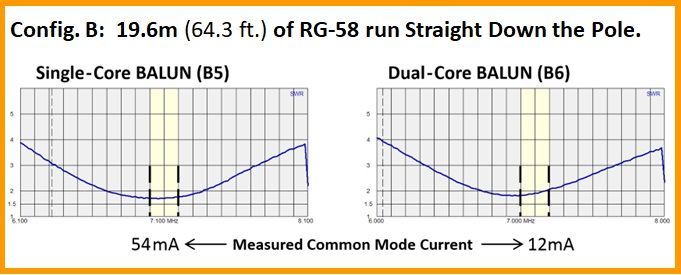
Here the common mode current has increased in both antennas. It is now 4.5x as great in the single core as in the dual-core.
EXAMPLE 3: 19.6m of coax, skewed radically to one side of the antenna. Although it is rare that someone would do this, sometimes people have less than perfect installations.

In this worst case scenario, the common mode current of the single core, though still just 3x as high as the dual-core, has reached a dangerous level. As can be seen, the SWR curve is much broader, and has a double dip. Although the double dips presents a nice load to the transmitter, the coax is now radiating about 58 Watts of power. The coax on the double-core is radiating about 5.5 Watts of power.
Power Calculations (P=I2R):
Assuming the impedance of the outer surface of the shield is similar to a thick wire, it must be on the order of 400 to 600 Ohms. Assume 500 Ohms.
Single-Core: .340 x .340 x 500 = 57.8 Watts Dual-Core: .105 x .105 x 500 = 5.5 Watts
Conclusion: in a clean installation with some lengths of coax, the difference is not huge. In less than perfect installations with some lengths of coax, the difference is huge and the consequence is a lot of power being radiated from the coax.
ADDRESSING COMMON MODE CURRENT ISSUES
IN LESS THAN PERFECT INSTALLATIONS:
To study this, I began with the worst-case configuration using a good dual-core 4:1 Guanella balun as shown in the bottom right graph above. As can be seen, residual Common Mode Current was 105 mA with 100 Watts of RF applied to the antenna.
I inserted a Common Mode Choke at the TX end of the coax and re-measured Common Mode Current, recording again the residual amount of current on the outside of the coax.
1:1 Maxwell Choke

Residual Common Mode Current: 105 mA
RadioWorks T4 Choke

Residual Common Mode Current: 66 mA
GM3SEK Mid-Range
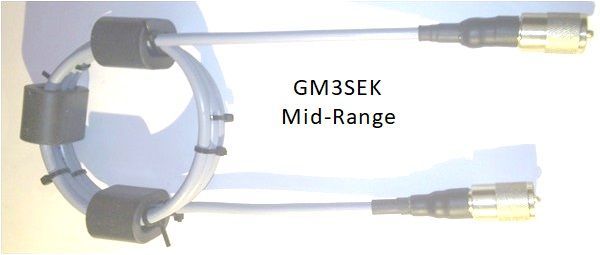
Residual Common Mode Current: ZERO
1:1 Guanella Choke

Residual Common Mode Current: 9 mA
In Summary:
- The simple Maxwell choke did not improve the situation.
- The T4 choke reduced Common Mode Current significantly.
- The GM3SEK Mid-Range choke removed all residual Common Mode Current.
- The 1:1 Guanella choke had a low residual Common Mode Current of 9 mA.
Either of the two chokes on the right may be used. The 1:1 Guanella is significantly smaller and lighter, thus better suited for mounting at the feedpoint of an antenna.
EVEN MORE STUBBORN CASES:
( Yes in some cases it is even worse! )
The extreme case shown below occurred at my home QTH when I moved my 80m OCFD antenna (which was close to the house) to a new position about 150 ft. behind and 50 ft. above the house:
In hopes of a better signal and lower noise level in the receiver, I relocated my antenna higher up the hill, farther away from the house.
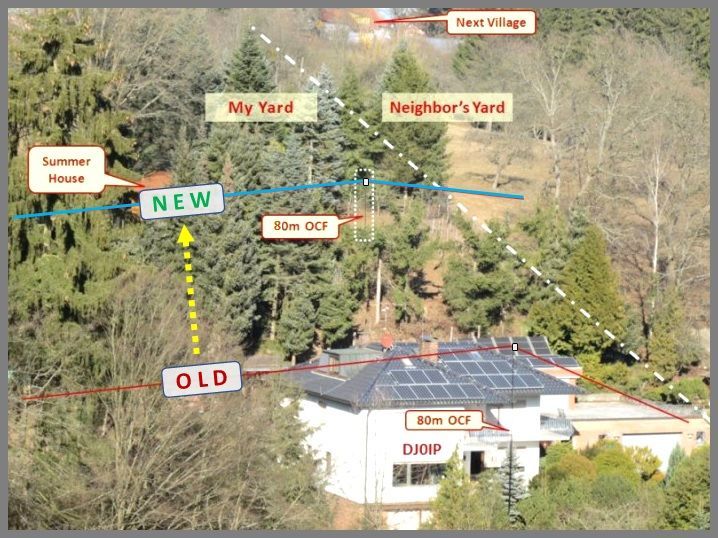
First measurements at the bottom of the pole looked good. Here's what the 20m SWR curve looked like:

DOUBLE BUBBLE, TOIL AND TROUBLE
I'VE GOT A DOUBLE-DIP!
It was obvious to me that I had Common Mode Current on the feedline . . . but why?
My balun was a Hybrid Balun including a very good 1:1 Guanella choke directly at the feedpoint. Here is what the run of coax to the shack looked like ->
I had thin Airborne-5 coax running up the thin fiberglass pole, and then thicker Airborne-10 coax continuing on to the shack. They were joined by a double-female PL connector. Initially the choke shown here at the bottom of the mast was not yet installed.
I later replaced the double-female connector with a Maxwell choke in an attempt to eliminate the Common Mode Current causing the Double Dip.
View from ground level. The new antenna was not only higher, performance was better and noise was lower, but not without curious feedline trouble!
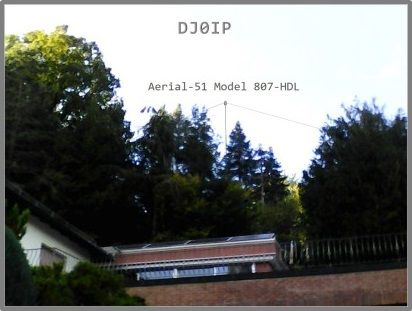
When I measured at the shack end of the coax I got an unpleasant surprise on 20m. That ugly Double-Dip had attacked my coax:
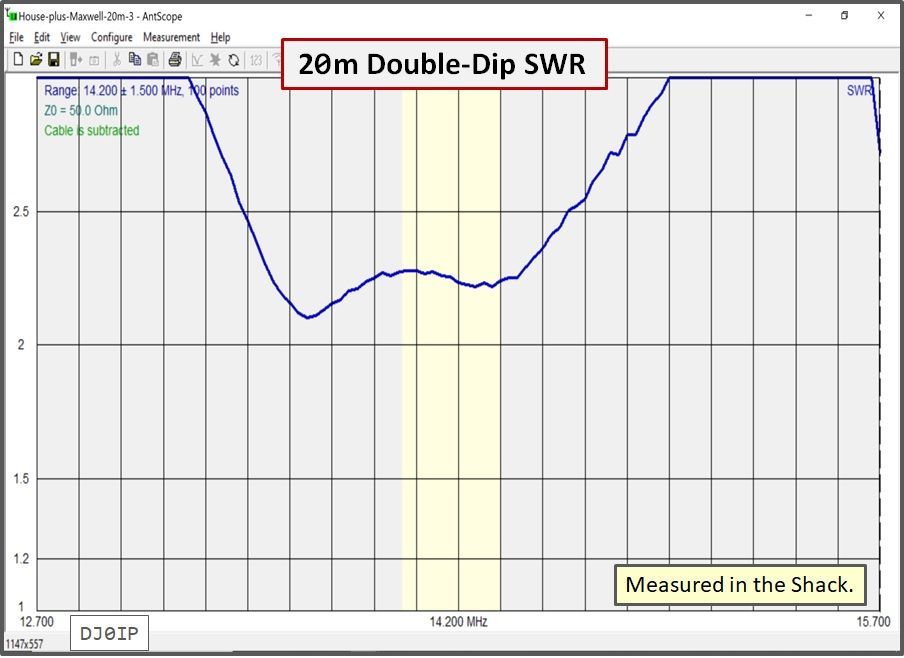
.
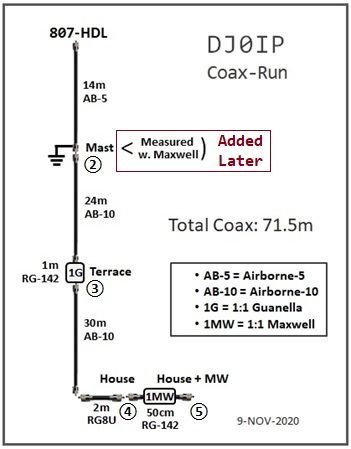
This is the path my coax HAD to be run: It's a long way to Tipperary!

The coax zig-zags back and forth on its way to the shack. Obviously not optimum, but it was the only way that I could run it. My Landlord did not want to see coax running through the air near his house.
I did not know what was causing the Common Mode Current problem on 20m; it could be reflections from the house, the garage, the solar panels . . . who knows? The only way I know to fight it is with RF chokes . . . but where?
Well I did not have any idea 'where' to place it but, since I already had a Guanella choke about λ/2 away from the feedpoint, the convenient place to insert another choke was between the Airborne-5 and the Airborne-10 coax at the bottom of the fiberglass pole.
SOLUTION TO THE PROBLEM: I replaced the double-female connector at the base of the pole with a Maxwell choke and grounded the shield on one side. But which side should I ground?
Trial and Error: I tried it both ways. Guess what? It made no difference. BOTH ways worked. With the Maxwell choke inserted, the double dip in SWR at the shack disappeared!

Call it the luck of the Irish, the Maxwell choke solved my problem with the SWR double-dip in the shack.
20m was the only band that I had problems on.
Sometimes, RF takes STRANGE ways!

SUMMARY AND CONCLUSION:
Simply relying on an SWR meter as an indication of the goodness of an antenna can be very dangerous!
In the 5 or 6 times that I have run into a double-dip in SWR, either at my QTH or at a friend's QTH, the problem has always been on the fundamental band, where the level of Common Mode Current is typically a magnitude higher than on the harmonic bands. In all of those cases, the solution was to add more Common Mode Impedance (i.e., more choking) directly at the feedpoint.
In consideration of Fractional Bandwidth, 80m is a very broad band, compared to the bandwidth of a dipole. The broad-banded SWR caused by a double dip "appears" to be beneficial; but it's not. It can cause a variety of undesired effects, which are listed at the middle of this page: When CMC Flows on the Coax
My best guess at the cause of the double-dip in this case is the zig-zag routing of the coax, and/or possible reflections from metal in the house or garage.
SIDEBAR:
FRACTIONAL BANDWIDTH

Fractional Bandwidth is the ratio of the bandwidth of a band to its center frequency.
The lower the FBW percentage. the more broad-banded a dipole antenna will be on that band.
80m is our most critical HF band, followed by 10m.
BTW: In case you are interested in how the new antenna at the new location compared to the old antenna at the old location, I have several charts (by band) showing the results.
SEE: New vs. Old Antenna
